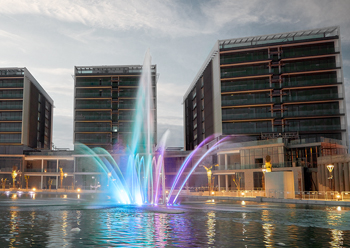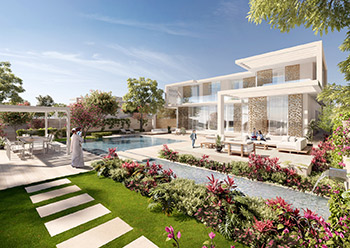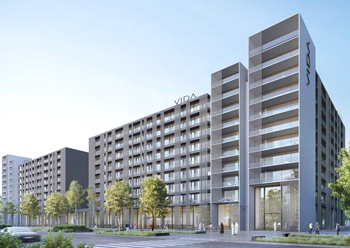
 Measuring 1.7 km, Dilmunia Canal is surrounded by public promenades, boardwalks, event plazas, and viewing decks, in addition to walkways and bridges.
Measuring 1.7 km, Dilmunia Canal is surrounded by public promenades, boardwalks, event plazas, and viewing decks, in addition to walkways and bridges.
Phase One of the Dilmunia Canal – Bahrain’s largest manmade water canal stretching from Dilmunia Marina in the north to Dilmunia Garden in the south – was opened for the public last month.
Measuring 1.7 km, Dilmunia Canal provides a central link between the districts within Dilmunia, a $1.6-billion mixed-use development built on a man-made island off the coast of Muharraq governorate.
It flows past existing projects like the CanalView and Hanging Gardens, two mixed-use projects constructed on the canal edges, and meanders around the Mall of Dilmunia, a destination by itself for the facilities and shopping experiences provided to visitors.
The canal will have a variety of water features, including waterfalls, innovative water jets and dancing coloured fountains, and is surrounded by public promenades, boardwalks, event plazas, and viewing decks. Walkways and bridges are strategically located across the canal, allowing visitors to admire distinctive water features such as the Waterfall Crossing.
 |
|
The canal will have a variety of water features, including waterfalls, water jets and dancing coloured fountains. |
In the evenings, it will feature spectacular light and water shows, where seawater-operated fountains spread over 100 m will create dazzling multimedia shows and choreographed water patterns using more than 1,200 colour-changing LEDs.
The second phase will feature more fountains, while the third will include a marina. Construction work on Phases Two and Three, which continue northwards, will start mid-2021 and is expected to finish by the end of 2022.
The Dilmunia Canal was designed by French firm Sogreah Gulf-Artelia Group, constructed by Cebarco Bahrain, and supervised by Ansari Engineering Services Construction. It is being developed by Ithmaar Development Company (IDC), master developer of the 125-hectare Dilmunia megaproject.
Commenting on the project, Mohammed Khalil Alsayed, IDC CEO, says: “In line with our commitment to delivering value for residents, visitors and investors, this latest development is expected to become the venue for many memorable events and a key attraction for families throughout the year. We also hope that the Dilmunia Canal and Fountain will be an interesting tourist attraction in Bahrain.”
The project’s contractors have ensured quality work and equipment. The pumping station, south of the island that brings water to the canal, was constructed by Cebarco and the machinery was acquired from the US, Germany and Italy.
Water is pumped from the sea and transported through underground pipes, and let out at the point where Phases One and Two meet. Water flows by gravity, southwards, where it falls near Canal View, and northwards, where it falls into the marina.
The project’s features include:
• Dilmunia Fountains: This key attraction was designed and installed by German firm Oase, known for building features around the world, in cooperation with Bahraini firm MH Al Mahroos;
• Canal Walk, with retailed outlets throughout its length on both sides; and
• Pedestrian bridges with globally-inspired designs, including the Canal View bridge; Venice bridge, which takes its design from bridges in Venice, Italy; and da Vinci’s bridge, the second of the two bridges designed along the lines of Leonardo da Vinci’s unbuilt bridge design dating centuries back – the first of which is in Norway.
All environmental aspects were considered when constructing the Dilmunia Canal, says Alsayed. “We did an environment assessment. Sogreah-Artelia took every aspect into consideration including hydrodynamic modelling.”
Jean-Claude Bejjani, Project Director, IDC, says the canal will be drained periodically for cleaning, adding that emptying the 1.3-m-deep canal will take 24 hours.
“The water features equipment will then be exposed to sunlight to deactivate harmful organisms.”
Alsayed says Dilmunia Canal aims to be a premier family-friendly venue for events ranging from food festivals to art exhibitions and sports competitions. Water taxis will also be introduced at a later stage, he adds.
To date, around $590 million has been invested in Dilmunia, with $320 million worth of investments in the pipeline, including several projects in the design and planning phases, according to Alsayed.
“Demand in Dilmunia has gone up with the progress of work on the canal work,” he concludes.
– By Abdulaziz Khattak.

















.jpg)













 (1).jpg)


















































